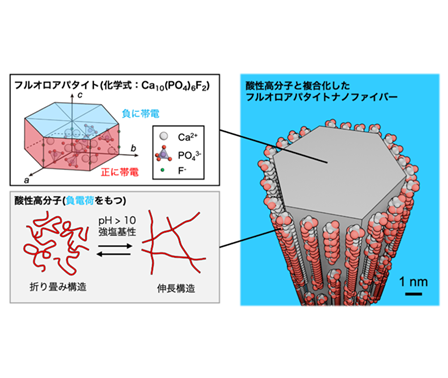Biomineral Nanofibers Composed of Shark Teeth Components Synthesized under Mild Aqueous Conditions
- Environmentally Low-Impact, Next-Generation Inorganic Nanofiber Materials Exhibiting Excellent Dispersibility and Liquid Crystalline Alignment -
Key Points
・Successful synthesis of ultrathin nanofiber materials primarily composed of fluoroapatite, the inorganic component of tough shark teeth, under mild aqueous conditions, and the subsequent development of nanocomposites using these fibers.
・By using a polymer template that mimics the function of proteins, ultrathin biomineral nanofibers were synthesized, successfully achieving liquid crystallinity--spontaneous alignment in the presence of water.
・As an environmentally friendly, next-generation nanofiber material, applications are anticipated not only in the bio and medical fields leveraging their biocompatibility and biodegradability, but also in functional devices utilizing their liquid crystalline properties.
Overview of This Research
Overview
A research group including graduate student Takahiro Mikami, Project Researcher Riki Kato (at the time of research, now Assistant Professor at Okayama University), and Professor Takashi Kato (at the time of research, now Professor Emeritus at the University of Tokyo, Project Professor at Okayama University, and Project Professor at Shinshu University), all from the Graduate School of Engineering at the University of Tokyo, in collaboration with Associate Professor Nobuyoshi Miyamoto of the Faculty of Engineering at Fukuoka Institute of Technology, successfully synthesized a nanofiber material primarily composed of fluoroapatite (Note 1), the inorganic component of tough shark teeth, under mild aqueous conditions (Note 2).
This research mimics the biological mechanism by which biominerals (Note 3) such as teeth and bones are formed. By controlling the stereostructure of an acidic polymer to mimic the function of proteins, they achieved the synthesis of high-aspect-ratio (Note 4) fluoroapatite nanofibers in a mild aqueous environment.
Furthermore, the electrostatic repulsion of the acidic polymer compounded on the surface allows the nanofibers to exist as a stable colloid (Note 5) in water and exhibit liquid crystallinity (Note 6), spontaneously forming ordered structures above a certain concentration. They also demonstrated that this liquid crystallinity can be leveraged to develop nanocomposite gels (Note 7) with anisotropic structures, such as enhanced strength in specific directions.
The fluoroapatite nanofibers developed in this study possess excellent biocompatibility and biodegradability (bio-absorbability), and due to their stability as a difficult-to-dissolve compound, they are considered an environmentally low-impact, next-generation nanofiber material. Future applications are expected not only in bio-materials and medicine, such as artificial bones and implants, as a reinforcement for environmentally low-impact and biocompatible composites, but also in devices and functional elements utilizing their liquid crystalline properties.
This research was published as an Early View in the German international science journal "Advanced Materials" on November 10, 2025.
Research Details
<Background>
In recent years, rising environmental awareness has created a demand for sustainable and environmentally low-impact nanomaterials. While the practical application of natural organic polymer-derived nanofiber materials like cellulose nanofibers is advancing due to their low environmental impact, inorganic nanofiber materials, which offer excellent heat and chemical resistance, have not been sufficiently studied from a sustainability perspective. Nature provides examples of skillfully utilized sustainable inorganic nanofiber materials. For instance, in the enameloid of shark teeth (equivalent to human tooth enamel), fluoroapatite nanofibers are aligned within an organic polymer matrix, achieving the highest hardness among biological materials. Although this material is a promising candidate for a sustainable inorganic nanofiber material, a method for synthesizing high-aspect-ratio fluoroapatite nanofibers while suppressing aggregation had not been established.
<Content of the Research>
The research group, inspired by the biomineralization mechanism of bone and teeth, developed a new synthesis method utilizing the stereostructural control of an acidic polymer (Figure 1a). In biomineral formation, the acidic sites of proteins control crystal growth, and their stereostructure is known to play a crucial role. Applying this principle, the group attempted to synthesize high-aspect-ratio fluoroapatite nanofibers by sufficiently stretching an acidic polymer under strong basic conditions.
As a result, they succeeded in synthesizing nanofibers with a length of 1-2μm and a diameter of approximately 8nm in a solution with pH10 or higher (Figure 1b). The acidic polymer compounded on the fiber surface induces electrostatic repulsion, achieving a stable, dispersed colloidal state. Furthermore, these nanofibers self-assembled and exhibited liquid crystallinity in water at a volume fraction of only about 0.2% (Figure 1c). While irreversible aggregation is generally a problem for liquid crystal formation, this research succeeded in stabilization through acidic polymer compounding.
The liquid-crystalline nanofibers showed excellent response to an external electric field, similar to liquid crystal display materials. By aligning the nanofibers in one direction using an external electric field and then fixing them within a gel, they produced a nanocomposite gel with an anisotropic structure (Figure 2). This gel exhibited a change in mechanical properties depending on the alignment direction: it was hard and brittle in the alignment direction, and soft and tenacious in the perpendicular direction.
Figure 1: Synthesis Strategy and Observation of Fluoroapatite Nanofibers
(a) Synthesis strategy of fluoroapatite nanofibers.
(b) Transmission Electron Microscope (Note 8) image of fluoroapatite nanofibers.
(c) Fluoroapatite nanofibers dispersed in water. When observed through a polarizer, textures originating from the liquid crystalline structure can be seen.
Figure 2: Nanocomposite Gel Compounded with Fluoroapatite Nanofibers
(a) Schematic illustration of the nanocomposite gel aligned by an electric field.
(b) Alignment structure of fluoroapatite nanofibers in the gel revealed by electron microscopy.
(c) Mechanical properties varying depending on the orientation of the nanofibers.
Future Prospects
The fluoroapatite nanofibers developed in this study can be synthesized using an environmentally low-impact method--under mild aqueous conditions--and exhibit stable dispersibility and liquid crystallinity even with a high aspect ratio. Fluoroapatite is the fluorine-substituted analog of hydroxyapatite, which constitutes our teeth and bones. Due to its excellent biocompatibility, acid resistance, and corrosion resistance, it is anticipated for use in medical fields such as artificial bones and implants. Moreover, its application is expected in the development of devices leveraging its liquid crystallinity, and in new fields based on its heat and chemical resistance.
Related Information:
"Press Release ① World's First Successful Alignment Control through Liquid Crystallization of Hydroxyapatite, a Component of Human Teeth and Bones: Anticipated Application in Next-Generation Biomaterials such as Artificial Bones and Dental Implants" (February 9, 2018)
Presenters and Researchers Information
The University of Tokyo, Graduate School of Engineering, Department of Chemistry and Biotechnology
Takashi Kato
At the time of research: Professor
Current positions: Professor Emeritus, The University of Tokyo
Project Professor, Institute for Advanced Study (Research Institute for Interdisciplinary Science), Okayama University
Distinguished Project Professor, Institute for Aqua Regeneration, Shinshu University
Riki Kato
At the time of research: Project Researcher
Current position: Project Assistant Professor, Institute for Advanced Study (Research Institute for Interdisciplinary Science), Okayama University
Takahiro Mikami
Doctoral Program (JSPS Research Fellow)
Fukuoka Institute of Technology, Faculty of Engineering
Nobuyoshi Miyamoto
Associate Professor
Publication Information
Journal: Advanced Materials
Title: Liquid-Crystalline Biomineral Nanofibers: 1D Inorganic Materials with a High Aspect Ratio and Anisotropic Self-Assembled Nanocomposites
Authors: Takahiro Mikami, Riki Kato, Nobuyoshi Miyamoto, Takashi Kato*
DOI: 10.1002/adma.202514457
URL: https://doi.org/10.1002/adma.202514457
Funding
This research was supported by the following Grants-in-Aid for Scientific Research from the Japan Society for the Promotion of Science (JSPS) and the Ministry of Education, Culture, Sports, Science and Technology (MEXT):
JSPS KAKENHI (Grant-in-Aid for Scientific Research)
"Grant-in-Aid for Scientific Research on Innovative Areas" (Grant Numbers: JP19H05714, JP19H05715)
"Grant-in-Aid for Scientific Research (B)" (Grant Number: JP25K01625)
"Grant-in-Aid for JSPS Fellows" (Grant Number: JP24KJ0621)
MEXT "Advanced Research Infrastructure for Materials" Project (Grant Numbers: JPMXP1223UT0106, JPMXP1224UT0078, JPMXP1225KU1036)
Glossary
(Note 1) Fluoroapatite:An inorganic calcium phosphate crystal represented by the chemical formula Ca10(PO4)6F2. In nature, it is found in places like the surface layer of shark teeth. It has a high biocompatibility, possessing a structure where the hydroxyl group (OH-) of hydroxyapatite (Ca10(PO4)6OH2), the main component of human teeth and bones, is substituted by a fluoride ion (F-). It is said to have superior acid resistance, dissolution resistance, and abrasion resistance compared to hydroxyapatite.
(Note 2) Nanofiber Material:Generally refers to an ultra-fine fibrous substance with a diameter of approximately 1 to 100 nm (hundreds of times thinner than a human hair) and a length at least 100 times its diameter. Cellulose nanofiber, derived from natural polysaccharides, is a typical example, and technological development towards its practical use is progressing.
(Note 3) Biomineral:Hard tissues produced by living organisms, such as teeth, bones, and the nacre of seashells. They possess elaborate structures built hierarchically from the nano- to macro-scale, and exhibit mechanical and optical properties derived from these structures. Because they form such structures under mild conditions close to room temperature and atmospheric pressure, they are actively researched from both materials chemistry and biology perspectives.
(Note 4) Aspect Ratio:An indicator of the shape of particles or fibers, which is the ratio of the length in the longest direction divided by the length in the shortest direction. For rod-shaped particles, it is the ratio of the particle's length to its diameter. A larger aspect ratio indicates a more elongated shape, while a ratio close to 1 indicates a shape closer to spherical, with similar length and width.
(Note 5) Colloid:A state where fine particles with a diameter of approximately 1 nanometer to 1 micrometer are dispersed seemingly uniformly within a liquid (or gas or solid), such as milk or India ink. In some cases, the dispersed particles themselves are also referred to as a colloid.
(Note 6) Liquid Crystallinity:A property of a substance that possesses both the fluidity of a liquid and the regular order of a crystal. Because their structure can be changed by the external environment, they are applied in displays and sensor devices.
(Note 7) Nanocomposite Gel:A solid with a network structure that swells by including a solvent is called a gel. A nanocomposite gel is a gel where nano-sized particles are confined within this network structure, resulting in a composite material with nanoparticles.
(Note 8) Transmission Electron Microscope (TEM):A device that obtains a magnified image of a specimen by magnifying an electron beam that has passed through the specimen using electromagnetic lenses. In this research, the shared equipment installed at the University of Tokyo under the MEXT Advanced Research Infrastructure for Materials Project was utilized.
Contact Information
<Regarding Research Content>
Takashi Kato, Professor Emeritus, The University of Tokyo
(Former Professor, Department of Chemistry and Biotechnology, Graduate School of Engineering, The University of Tokyo)
Tel: +81-3-5841-7440
E-mail: t-tkato@g.ecc.u-tokyo.ac.jp
<Institutional Contacts>
The University of Tokyo, Graduate School of Engineering, Public Relations Office
Tel: +81-3-5841-0235
E-mail: kouhou@pr.t.u-tokyo.ac.jp
Okayama University, General Affairs Department, Public Relations Division
Tel: +81-86-251-7292
E-mail: www-adm@adm.okayama-u.ac.jp
Shinshu University, General Affairs Department, General Affairs Division, Public Relations Office
Tel: +81-263-37-3056
E-mail: shinhp@shinshu-u.ac.jp
Fukuoka Institute of Technology, Admissions and Public Relations Division
Tel: +81-92-606-0607
E-mail: ko-ikeda@fit.ac.jp Fax: +81-92-606-7357







